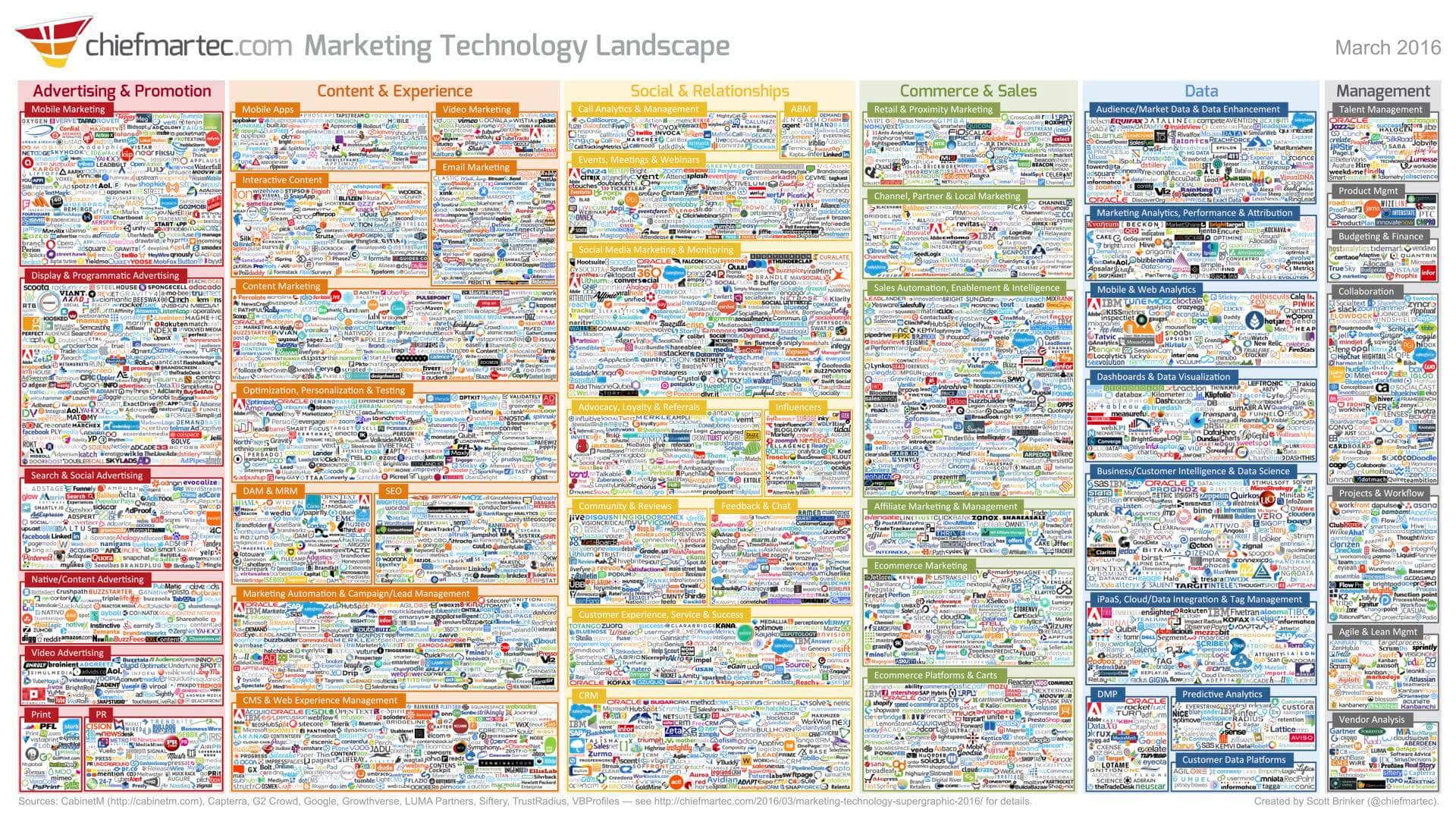If you’re in marketing, you’ve seen the infamous Martech 5000 Marketing Technology Landscape infographic.

Yep, that’s the one. This graphic began in 2011 with only 150 companies and has since grown to around 5,000 technologies – and it’s not stopping there. One look at this graphic and it’s clear that endless options exist for marketers who are looking to make their lives easier and their performance better.
The mix of marketing technologies a team uses is called a Marketing Stack. According to Optimizley, a marketing stack is “a grouping of technologies that marketers leverage to conduct and improve their marketing activities.” Many times, the goal of a marketing stack is to make processes more efficient and to measure the effectiveness of current marketing campaigns.
However, for your marketing stack to be successful in driving the overall effectiveness of your marketing campaigns, your team must choose the right technologies to utilize. Traditional marketing stacks have typically involved the following areas: Customer Relationship Management (CRM), Insights and Analysis, Experience Optimization, Search Engine Optimization (SEO) and Advertising Technology.
For marketers looking to the future, there’s one more critical tool to add: an online brand community. Read on for four ways an online brand community enhances your marketing stack.
1. Consumer Relationships are No Longer a One-Way Email Push
There’s no doubt that a CRM is an essential tool in the marketing toolbox, tracking the consumers who opt-in to your communications. However, although many brands have huge databases with regularly scheduled email campaigns, these emails are often a one-way push to consumers – the brand isn’t receiving anything in return. In fact, research from eMarketer says only 30 percent of US email subscribers actually make purchases from the brand’s list they are subscribed to. Even when consumers are engaging with emails from brands, most interactions are simply a transactional experience, lacking the crucial component that delivers long-term loyalty and advocacy. Or even worse, a CRM simply becomes a behind-the-scenes database desert with no engagement.
When marketers create an online brand community, they create a social CRM, turning their communication with consumers into a two-way relationship. Like a CRM, consumers are opting-in to a online brand community – they want to hear from the brand, engage with the brand and advocate for the brand. Housing consumers in an online brand community allows you to ask consumers: What do you want to hear about? How often do you want to hear from us? Brands can then send more personalized communication and consumers can provide feedback to the brand.
2. Insights & Analysis Turned into Enhanced Experience
The ability to measure marketing campaign activity is crucial for any brand, and most teams have third-party technologies dedicated specifically to uncovering this data such as Google Analytics or HubSpot.
But when a brand creates an online community, third-party data becomes zero-party data – given directly by willing consumers and taking only days to gather results, not weeks or months. This means brands can optimize their marketing campaigns more efficiently and make business decisions even quicker.
For example: if you’re launching a new product and you need ideas on which packaging to choose, you can turn to your community of consumers, who represent your target audience and ask their opinion. Using the data from your online community will enable you to ensure a successful user experience in the market.
Enhancing user experience, however, goes far beyond packaging. Today’s consumers are looking for an enhanced experience through personalized communication and offers from a brand. In fact, our research shows that 90 percent of consumers are willing to share personal information with a brand in exchange for personalized communication and are more likely to engage with a personalized offer.
Many marketers say the biggest challenge to delivering personalized content is gaining the right insights about their consumers. Experian says that 40 percent of marketers can’t gain insights quickly enough and 39 percent of marketers don’t have enough data.
Choosing an online community management software that consistently builds out members’ profiles through their responses to surveys and actions taken in the community allows marketers to segment members through both demographic and psychographic data. Creating these micro-audiences ensures that each member sees personalized and relevant content.
3. Optimized Ad Spend With Ideal Target Audiences
Advertising is a key customer acquisition technique, and it’s not slowing down anytime soon: Magna, the research arm of IPG Mediabrands, says digital ad spending will grow 13 percent in 2018 to $237 billion. That’s a lot of spending, which is why most marketers use third-party technologies to monitor the efficiency of these campaigns and marketers are always looking for ways to optimize their spend.
Enter: an online community. Cultivating an online community helps marketers refine their audience targeting for more effective media spend. After all, what better lookalike audience is there than your most ardent community advocates?
An online brand community that uncovers granular data to identify your most engaged members allows marketers to create ideal lookalike audiences and retarget existing, highly-engaged members to enhance engagement and ROI.
4. Using an Online Brand Community to Boost SEO
It’s 2018, and we all understand the continued importance of SEO: HubSpot says “61 percent of marketers say improving SEO and growing their organic presence is their top inbound marketing priority.” As SEO trends are constantly changing, online brand communities are a surefire way to ensure authentic and quality user-generated content.
Building a community of people who love your brand allows you to easily activate consumers to produce fresh and unique user-generated content, leading to an ongoing portal of content – this is helpful for both getting new eyes on your products.
Forty-eight percent of consumers say user-generated content is a great way to find new products, and 25 percent of search results for the world’s 20 largest brands are links to user-created content. This is exciting news for marketers. Not only does content your advocates create hold a higher probability of showing up in search engines, but it also ensures the first thing consumers see is content they will trust.
Ready to get started on your own online brand community? Give us a shout. TINT’s online community platform allows you to mobilize and activate your brand’s advocates. Through TINT, brands can easily create a branded online community to generate engagement, collect feedback and spread content across social media – driving awareness, loyalty and advocacy, all with always-on audience segmentation, comprehensive analytics, and insightful visibility.



